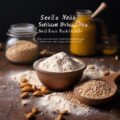The Wonderful World of Wholesome Breads
Bread has been a staple food for thousands of years, nourishing bodies and bringing people together around the table. While some modern diets eschew bread, there are many nutritious options that can be part of a healthy, balanced diet. Let’s explore some of the most wholesome bread choices and how they can support your wellbeing.
Whole Grain Goodness
When it comes to healthy bread, whole grain varieties shine. Unlike refined flours that strip away nutritious parts of the grain, whole grain breads retain the bran, germ, and endosperm. This means they’re packed with fiber, vitamins, minerals, and beneficial plant compounds. Some excellent whole grain bread options include:
- 100% whole wheat bread
- Sprouted grain bread
- Rye bread
- Oat bread
- Millet bread
These breads not only taste delicious but also provide sustained energy and support digestive health. The fiber helps you feel full and satisfied, making whole grain breads a compassionate choice for nourishing your body.
Sourdough: A Fermented Favorite
Sourdough bread has gained popularity in recent years, and for good reason. This traditional bread-making method uses wild yeast and bacteria to ferment the dough, creating a tangy flavor and unique texture. But the benefits go beyond taste:
- Easier to digest due to the fermentation process
- Lower glycemic index compared to many other breads
- May be better tolerated by those with mild gluten sensitivity
- Contains beneficial bacteria that support gut health
Enjoying a slice of sourdough can be a delightful way to care for your digestive system and savor the art of bread-making.
Gluten-Free Options for All
For those with celiac disease or gluten sensitivity, there are now many delicious gluten-free bread options available. These breads are often made from alternative flours such as:
- Almond flour
- Coconut flour
- Rice flour
- Quinoa flour
- Buckwheat flour (despite the name, it’s gluten-free!)
While gluten-free breads may have a different texture than traditional wheat breads, they can be just as nutritious and satisfying. Many are fortified with extra fiber and nutrients to ensure you’re getting the most out of your bread.
Nutrient-Enriched Varieties
Some bread varieties go above and beyond by incorporating extra nutrients and superfoods. These can be a great way to boost your intake of important vitamins and minerals. Look for breads that include:
- Seeds like flax, chia, or pumpkin seeds for omega-3 fatty acids
- Nuts for healthy fats and protein
- Dried fruits for natural sweetness and extra nutrients
- Vegetables like carrots or zucchini for added vitamins and moisture
These nutrient-dense breads can be a delicious way to care for your body and add variety to your meals.
Mindful Bread Consumption
While there are many healthy bread options available, it’s important to approach bread consumption mindfully. Here are some tips for enjoying bread as part of a balanced diet:
- Pay attention to portion sizes
- Pair bread with protein and healthy fats for a more balanced meal
- Choose breads with minimal added sugars and preservatives
- Consider making your own bread at home for ultimate control over ingredients
- Listen to your body and how different breads make you feel
Remember, the healthiest bread for you is one that makes you feel good and fits into your overall eating pattern. It’s about nourishing your body and soul, not adhering to strict rules.
FAQ: Your Burning Bread Questions Answered
Q1: Is bread bad for you?
A1: Bread itself is not inherently bad for you. Many types of bread, especially whole grain varieties, can be part of a healthy diet. The key is choosing nutrient-dense options and consuming them in moderation as part of a balanced eating plan.
Q2: How can I tell if a bread is truly whole grain?
A2: Look for “100% whole grain” or “100% whole wheat” on the label. Check the ingredients list – the first ingredient should be a whole grain flour. Be wary of terms like “made with whole grains” or “multigrain,” which don’t guarantee the bread is mostly whole grain.
Q3: Is sourdough bread healthier than regular bread?
A3: Sourdough bread can have some health advantages over regular bread due to its fermentation process. It may be easier to digest, have a lower glycemic index, and contain beneficial bacteria. However, the overall healthiness depends on the type of flour used and other ingredients.
Q4: Can bread be part of a weight loss diet?
A4: Yes, bread can be included in a weight loss diet when chosen wisely and eaten in moderation. Opt for whole grain breads that are high in fiber and pair them with protein and vegetables to create satisfying, balanced meals.
Q5: What’s the best way to store bread to keep it fresh?
A5: For short-term storage (2-3 days), keep bread in a bread box or paper bag at room temperature. For longer storage, slice the bread and freeze it. Avoid storing bread in the refrigerator, as this can actually make it go stale faster.
In conclusion, bread can be a delicious and nutritious part of your diet when you choose wisely. By opting for whole grain, sourdough, or nutrient-enriched varieties, you can enjoy the comfort and satisfaction of bread while nourishing your body. Remember to listen to your body, enjoy your food mindfully, and choose options that make you feel your best. Here’s to finding joy in every slice!









